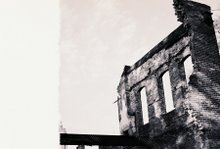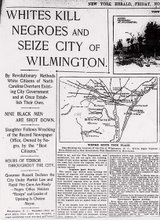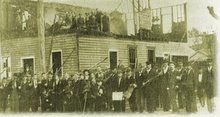Final Pitch
In November 1898, the first and only successful Coup D’etat to occur on US soil took place in Wilmington, North Carolina. The local, conservative Democratic Party forcibly toppled the city’s duly elected government, including two African American Aldermen. How is it possible that 109 years later almost no one in the town of Wilmington knows about this significant piece of history? That is the same question our group has asked. When we first began this project we had a wide variety of aspects we wanted to include in our documentary. We soon realized that there was no way that we could fit everything we wanted into 5-7 minutes, so we had to narrow our topic. So we decided the major focus of our project would be, Why is this significant piece of history not being taught in schools? At this point, we have some great B-roll footage, still photographs, and hours of interesting vox pop interviews. Even with all that we still need to shoot a bunch of other things to make our film even better. The things that we still need to shoot are: MLK street signs, Fire stations, Fire Hydrants, The Beach, Bonfires or fire burning, Burning newspapers, Archive photos, History book cover and pages, Vox pop from the black community, and an Expert Interview. With all these different mediums to work with our documentary should turn out very nice and end up being 5-7 minutes.
Why was my film rejected
I think that the information is very helpful and important to student filmmakers. For me I typically would have thought that longer shorts would have better chance than shorter. It is very helpful to me to know that is not the case. This is helpful to me because I now know to focus on condescending and focusing. I am starting to equate film with writing- shorter is better. To go straight to the point and efficiently utilize every frame and sound bite. This is in many ways easier and cheaper. It is also harder because it forces one to be more creative and concise. I feel happy to know that short shorts have an equal and better chance than longer shorts. This gives me more opportunities than I thought I had.
Amir
Amir
Why Was My Film Rejected? - Response
The guidance offered to film festival applicants on the DC Shorts website was biting, entertaining, and solid advice. However, none of it was shocking or discouraging. It was a practical reiteration of the repeated lessons heard in production classes at UNCW - sound, editing, lighting, and story. It was a poignant reminder, especially to those of us pursuing careers in independent film, that success in filmmaking is enormously demanding. There were certain specific hints offered that were particularly useful. The warning against editing one's own project was a little rattling - so many of us aspire to have a hand in multiple aspects of the collaborative art form. The appeal of a good comedy is obviously rare, but I was a little surprised that the genre was set apart as having a particular pull in festivals. The one really striking piece of advice to me was - Work within the means of your crew, and think simple. Ego is not always a good thing to feed. This does not mean to limit oneself creatively, but merely to think within realistic limits of production. There is definately a level of perfectionism innate in quality filmmaking, and the advice supports that the same is expected by festivals. I look forward to the process - the lost money, repeated rejection, and thrill of filmmaking.
-tod
-tod
Why was my Film Rejected?
I thought that this article had a lot of useful information for anyone planning on submitting a film to a festival. Some of the things that it talked about were more common sense like, use a proper storytelling arc and use a independent professional editor. On the other hand, there were a lot of things it talked about that I had no idea were so important. One thing that is very important to the judges is the use of good camera shots. Making sure actors are properly in frame and keeping the handheld shots steady are major. Judges also keep a close eye on acting and lighting, so filmmakers should use proper actors for the role and have an experienced DP and Grip to help with lighting. One thing that the article mentioned that I found to be very true is keep your movie simple and do what can be successfully attained by the number and experience of the crew you have. Many films are lost because they are overly ambitious. The article also gives a bunch of small tips to remember when submitting a film. One tip that I thought was very simple but very important was to submit your movie in a nice DVD clamshell case in a bubble wrap envelope with some sort of promo item (film review, production still, etc.). After reading this article I now have a better idea of what kind of things to look out for when submitting a movie to a festival.
-Brad
-Brad
Story board

1. Newspaper burning
2. Statue honoring Confederate Officer
3. Confederate flag
4. Highway/"Welcome to Wilmington" sign
5. Upscale home
6. Impoverished neighborhood
7. Hugh MacCrae Park
8. Basketball court on corner of 10th and Castle Street
9. Swamp lands where African Americans fled during 1898 Riots
10. Tranquil sunset on beach
Ideal and Reasoning of Poetic Project
The Poetic Form may contribute to a great deal of our film. If it were not for historical and educational considerations, we, as filmmakers, would prefer to make the entire project a poetic piece. However, our desire for open communication and education on the Wilmington Riots of 1898 drives us to incorporate multiple approaches. Utilizing the poetic form, we will juxtapose the socio-economic conditions of African American neighborhoods with majority white neighborhoods in Wilmington, NC. The poetic portion of the film may establish the theme and set the structure and rythym of the entire project. We hope to stumble upon honesty as we roam the downtown streets and out-stretches of Wilmington.
Shooting Schedule - Poetic Form
- Thursday, April 5: 2 pm - 7pm
Set Shots: newspaper on fire, confederate statue, Wilmington from the 74/76 bridge, ABC Store (17th St), Oleander stores,
fire stations, signs (Welcome to Wilmington), north downtown homes, south downtown homes (restored),
Star News, Wilmington Journal.
- Friday, April 6: 4 pm - 8 pm
History and Atmosphere Shots: Walk through north side of downtown Wilmington, from N.4th to N.11th. We will follow the
path of the riots and note historic marks according to archival maps.
- Saturday, April 7: 10 am - 3 pm
Spontaneous Shots: downtown Wilmington, Hugh MacCrae Park, Urban Park.
Set Shots: newspaper on fire, confederate statue, Wilmington from the 74/76 bridge, ABC Store (17th St), Oleander stores,
fire stations, signs (Welcome to Wilmington), north downtown homes, south downtown homes (restored),
Star News, Wilmington Journal.
- Friday, April 6: 4 pm - 8 pm
History and Atmosphere Shots: Walk through north side of downtown Wilmington, from N.4th to N.11th. We will follow the
path of the riots and note historic marks according to archival maps.
- Saturday, April 7: 10 am - 3 pm
Spontaneous Shots: downtown Wilmington, Hugh MacCrae Park, Urban Park.
Subscribe to:
Comments (Atom)


